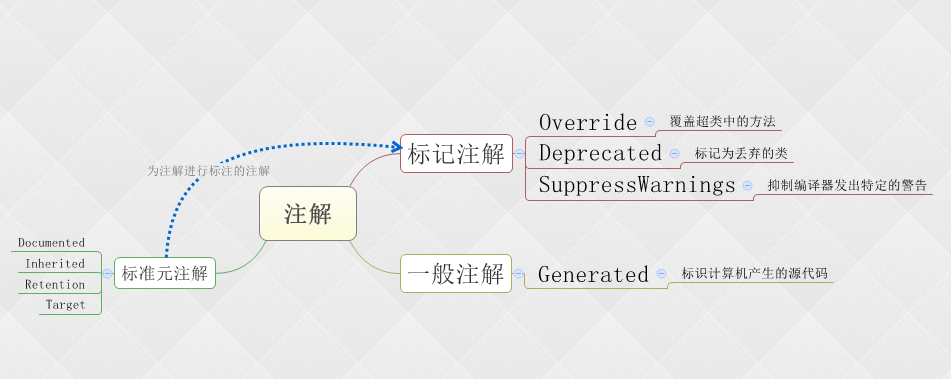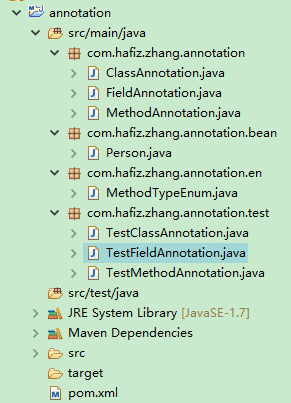本文共 8541 字,大约阅读时间需要 28 分钟。
一、背景
最近在自己搞一个项目时,遇到可需要开发自定义注解的需求,对于没有怎么关注这些java新特性的来说,比较尴尬,索性就拿出一些时间,来进行研究下自定义注解开发的步骤以及使用方式。今天在这里记下,方便以后学习复习以及分享给有需要的小伙伴们~
二、注解基本概念
什么是注解?
注解就是某种注解类型的一个实例,我们可以用它在某个类上进行标注,这样编译器在编译我们的文件时,会根据我们自己设定的方法来编译类。
注解的分类有哪些?

由上图可知:注解共分为:标记注解、标准元注解、一般注解三类。
注:Deprecated注解,除了多个删除线,并没有什么拦截功能。
标准元注解详解
标准元注解是自定义注解的注解,主要包含4个,都位于java.lang.annotation包中,我们创建自定义注解时会用到4个标准元注解。它们的名称以及含义如下:
1. @Documented:用于描述其它类型的annotation应该被作为被标注的程序成员的公共API,因此可以被例如javadoc此类的工具文档化。是一个标记注解,没有成员。
2. @Inherited:是一个标记注解阐述了某个被标注的类型是被继承的。使用了@Inherited修饰的注解类型被用于一个class时该class的子类也有了该注解。
3. @Retention:定义了该注解的生命周期:某些注解仅出现在源代码中,而被编译器丢弃;而另一些却被编译在class文件中;编译在class文件中的注解可能会被虚拟机忽略,而另一些在class被装载时将被读取(请注意并不影响class的执行,因为注解与class在使用上是被分离的)。使用这个元注解可以对自定义注解的“生命周期”进行限制。
生命周期策略枚举
RetentionPolicy.RUNTIME 注解会在class字节码文件中存在,在运行时可以通过反射获取到。
RetentionPolicy.CLASS 默认的保留策略,注解会在class字节码文件中存在,但运行时无法获得。
RetentionPolicy.SOURCE 注解仅存在于源码中,在class字节码文件中不包含。
4. @Target:说明了注解所修饰的对象范围:注解可被用于 packages、types(类、接口、枚举、Annotation类型)、类型成员(方法、构造方法、成员变量、枚举值)、方法参数和本地变量(如循环变量、catch参数)。
修饰范围枚举
ElementType.CONSTRUCTOR 作用于构造器
ElementType.FIELD 作用于域/属性 ElementType.LOCAL_VARIABLE 用于描述局部变量 ElementType.METHOD 作用于方法 ElementType.PACKAGE 用于描述包 ElementType.PARAMETER 用于描述参数 ElementType.TYPE 用于描述类、接口(包括注解类型) 或enum声明,最常用三、开发自定义注解demo
1.开发自定义类注解
1 package com.hafiz.zhang.annotation; 2 3 import java.lang.annotation.Documented; 4 import java.lang.annotation.ElementType; 5 import java.lang.annotation.Retention; 6 import java.lang.annotation.RetentionPolicy; 7 import java.lang.annotation.Target; 8 9 /**10 * @author hafiz.Zhang11 * @Date 2016年5月18日 下午1:58:1112 * @Description 自定义类注解13 */14 @Documented //定义可以被文档工具文档化15 @Retention(RetentionPolicy.RUNTIME)//声明周期为runtime,运行时可以通过反射拿到16 @Target(ElementType.TYPE)//注解修饰范围为类、接口、枚举17 public @interface ClassAnnotation {18 public String name() default "defaultService";19 public String version() default "1.1.0";20 } 2.自定义方法注解
1 package com.hafiz.zhang.annotation; 2 3 import java.lang.annotation.Documented; 4 import java.lang.annotation.ElementType; 5 import java.lang.annotation.Retention; 6 import java.lang.annotation.RetentionPolicy; 7 import java.lang.annotation.Target; 8 9 import com.hafiz.zhang.annotation.en.MethodTypeEnum;10 11 /**12 * @author hafiz.Zhang13 * @Date 2016年5月18日 下午1:58:2614 * @Description 自定义方法注解15 */16 @Documented17 @Retention(RetentionPolicy.RUNTIME)18 @Target(ElementType.METHOD)19 public @interface MethodAnnotation {20 public String name() default "defaultName"; 21 public MethodTypeEnum type() default MethodTypeEnum.TYPE1;22 } 3.自定义域注解
1 package com.hafiz.zhang.annotation; 2 3 import java.lang.annotation.Documented; 4 import java.lang.annotation.ElementType; 5 import java.lang.annotation.Retention; 6 import java.lang.annotation.RetentionPolicy; 7 import java.lang.annotation.Target; 8 9 /**10 * @author hafiz.Zhang11 * @Date 2016年5月18日 下午1:58:3712 * @Description 自定义域注解13 */14 @Documented15 @Target(ElementType.FIELD)16 @Retention(RetentionPolicy.RUNTIME)17 public @interface FieldAnnotation {18 public String name() default "defaultName";19 public String value() default "defaultValue";20 21 } 4.方法类型枚举类
1 package com.hafiz.zhang.annotation.en; 2 3 /** 4 * @author hafiz.Zhang 5 * @Date 2016年5月18日 下午1:59:02 6 * @Description 方法类型枚举类 7 */ 8 public enum MethodTypeEnum { 9 TYPE1,TYPE210 } 5.测试注解Bean
1 package com.hafiz.zhang.annotation.bean; 2 3 import com.hafiz.zhang.annotation.ClassAnnotation; 4 import com.hafiz.zhang.annotation.FieldAnnotation; 5 import com.hafiz.zhang.annotation.MethodAnnotation; 6 import com.hafiz.zhang.annotation.en.MethodTypeEnum; 7 8 /** 9 * @author hafiz.Zhang10 * @Date 2016年5月18日 上午11:59:3711 * @Description 测试使用的bean12 */13 @ClassAnnotation(name="personBean", version="1.2.1")14 public class Person {15 @FieldAnnotation(name="description", value="This is my personal annotation")16 private String description;17 18 public String getDescription() {19 return description;20 }21 22 public void setDescription(String description) {23 this.description = description;24 }25 @MethodAnnotation(name="sayHello", type = MethodTypeEnum.TYPE2)26 public void sayHello() {27 System.out.println("Hello Annotation!");28 }29 } 6.自定义类注解测试类
1 package com.hafiz.zhang.annotation.test; 2 3 import com.hafiz.zhang.annotation.ClassAnnotation; 4 import com.hafiz.zhang.annotation.bean.Person; 5 6 /** 7 * @author hafiz.Zhang 8 * @Date 2016年5月18日 上午11:56:34 9 * @Description 测试类注解10 */11 public class TestClassAnnotation {12 13 private static Person person = new Person();14 15 public static void main(String[] args) {16 Class clazz = person.getClass();17 //因为注解是作用于类上面的,所以可以通过isAnnotationPresent来判断是否是一个具有指定注解的类18 if(clazz.isAnnotationPresent(ClassAnnotation.class)) {19 System.out.println("This is a class with annotation ClassAnnotation!");20 //通过getAnnotation可以获取注解对象21 ClassAnnotation annotation = clazz.getAnnotation(ClassAnnotation.class);22 if(null != annotation) {23 System.out.println("BeanName = " + annotation.name());24 System.out.println("BeanVersion = " + annotation.version());25 }else{26 System.out.println("the annotation that we get is null");27 }28 }else{29 System.out.println("This is not the class that with ClassAnnotation");30 }31 }32 } 运行结果:

7.自定义方法注解测试类
1 package com.hafiz.zhang.annotation.test; 2 3 import java.lang.reflect.Method; 4 5 import com.hafiz.zhang.annotation.MethodAnnotation; 6 import com.hafiz.zhang.annotation.bean.Person; 7 8 /** 9 * @author hafiz.Zhang10 * @Date 2016年5月18日 下午12:11:1111 * @Description 测试方法注解12 */13 public class TestMethodAnnotation {14 15 private static Person person = new Person();16 17 public static void main(String[] args) throws Exception {18 Class clazz = person.getClass();19 //因为是注解到method上的,所以首先要获取这个方法20 Method method = clazz.getDeclaredMethod("sayHello");21 if(method.isAnnotationPresent(MethodAnnotation.class)) {22 System.out.println("===This is a method with a annotation:MethodAnnotation===");23 //通过getAnnotation可以获取注解对象24 MethodAnnotation annotation = method.getAnnotation(MethodAnnotation.class);25 if(null != annotation) {26 System.out.println("MethodName = " + annotation.name());27 System.out.println("MethodType = " + annotation.type());28 }else{29 System.out.println("the annotation that we get is null");30 }31 }else{32 System.out.println("This is not the class that with MethodAnnotation");33 }34 }35 } 运行结果:

8.自定义域注解测试类
1 package com.hafiz.zhang.annotation.test; 2 3 import java.lang.reflect.Field; 4 5 import com.hafiz.zhang.annotation.FieldAnnotation; 6 import com.hafiz.zhang.annotation.bean.Person; 7 8 /** 9 * @author hafiz.Zhang10 * @Date 2016年5月18日 下午12:17:4911 * @Description 测试域注解12 */13 public class TestFieldAnnotation {14 15 private static Person person = new Person();16 17 public static void main(String[] args) throws Exception {18 Class clazz = person.getClass();19 //因为是注解到Field上的,所以首先要获取这个字段20 Field field = clazz.getDeclaredField("description");21 //判断这个Field上是否有这个注解22 if(field.isAnnotationPresent(FieldAnnotation.class)) {23 System.out.println("===This is a field with annotation:FieldAnnotation!===");24 //如果有这个注解,则获取注解类25 FieldAnnotation annotation = field.getAnnotation(FieldAnnotation.class);26 if(null != annotation){27 System.out.println("before set the value is:" + person.getDescription());28 //通过反射给私有变量赋值29 field.setAccessible(true);30 field.set(person, annotation.value());31 System.out.println("after set the value is:" + person.getDescription());32 }else{33 System.out.println("the annotation that we get is null");34 }35 }else{36 System.out.println("This is not the class that with FieldAnnotation");37 }38 }39 } 运行结果:

附:demo项目结构图

以上就是本人对自定义注解开发的理解以及开发测试了,如有错误希望大家能够批评指正!
转载地址:http://efwbm.baihongyu.com/